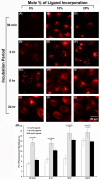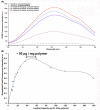Optimization of a nanomedicine-based silicon phthalocyanine 4 photodynamic therapy (Pc 4-PDT) strategy for targeted treatment of EGFR-overexpressing cancers
- PMID: 22775587
- PMCID: PMC3498539
- DOI: 10.1021/mp300256e
Optimization of a nanomedicine-based silicon phthalocyanine 4 photodynamic therapy (Pc 4-PDT) strategy for targeted treatment of EGFR-overexpressing cancers
Abstract
The current clinical mainstays for cancer treatment, namely, surgical resection, chemotherapy, and radiotherapy, can cause significant trauma, systemic toxicity, and functional/cosmetic debilitation of tissue, especially if repetitive treatment becomes necessary due to tumor recurrence. Hence there is significant clinical interest in alternate treatment strategies like photodynamic therapy (PDT) which can effectively and selectively eradicate tumors and can be safely repeated if needed. We have previously demonstrated that the second-generation photosensitizer Pc 4 (silicon phthalocyanine 4) can be formulated within polymeric micelles, and these micelles can be specifically targeted to EGFR-overexpressing cancer cells using GE11 peptide ligands, to enhance cell-specific Pc 4 delivery and internalization. In the current study, we report on the in vitro optimization of the EGFR-targeting, Pc 4 loading of the micellar nanoformulation, along with optimization of the corresponding photoirradiation conditions to maximize Pc 4 delivery, internalization, and subsequent PDT-induced cytotoxicity in EGFR-overexpressing cells in vitro. In our studies, absorption and fluorescence spectroscopy were used to monitor the cell-specific uptake of the GE11-decorated Pc 4-loaded micelles and the cytotoxic singlet oxygen production from the micelle-encapsulated Pc 4, to determine the optimum ligand density and Pc 4 loading. It was found that the micelle formulations bearing 10 mol % of GE11-modified polymer component resulted in the highest cellular uptake in EGFR-overexpressing A431 cells within the shortest incubation periods. Also, the loading of ∼ 50 μg of Pc 4 per mg of polymer in these micellar formulations resulted in the highest levels of singlet oxygen production. When formulations bearing these optimized parameters were tested in vitro on A431 cells for PDT effect, a formulation dose containing 400 nM Pc 4 and photoirradiation duration of 400 s at a fluence of 200 mJ/cm(2) yielded close to 100% cell death.
Figures





Similar articles
-
A cell-targeted photodynamic nanomedicine strategy for head and neck cancers.Mol Pharm. 2013 May 6;10(5):1988-97. doi: 10.1021/mp400007k. Epub 2013 Apr 24. Mol Pharm. 2013. PMID: 23531079 Free PMC article.
-
EGFR-mediated intracellular delivery of Pc 4 nanoformulation for targeted photodynamic therapy of cancer: in vitro studies.Nanomedicine. 2012 Jul;8(5):655-64. doi: 10.1016/j.nano.2011.09.012. Epub 2011 Oct 22. Nanomedicine. 2012. PMID: 22024195 Free PMC article.
-
Delivery of the photosensitizer Pc 4 in PEG-PCL micelles for in vitro PDT studies.J Pharm Sci. 2010 May;99(5):2386-98. doi: 10.1002/jps.22007. J Pharm Sci. 2010. PMID: 19967780
-
Pharmaceutical development, composition and quantitative analysis of phthalocyanine as the photosensitizer for cancer photodynamic therapy.J Pharm Biomed Anal. 2014 Jan;87:98-104. doi: 10.1016/j.jpba.2013.05.014. Epub 2013 May 18. J Pharm Biomed Anal. 2014. PMID: 23746989 Review.
-
Phthalocyanine-Biomolecule Conjugated Photosensitizers for Targeted Photodynamic Therapy and Imaging.Curr Drug Metab. 2015;16(9):816-32. doi: 10.2174/1389200217666151120165404. Curr Drug Metab. 2015. PMID: 26593738 Review.
Cited by
-
Triple-responsive expansile nanogel for tumor and mitochondria targeted photosensitizer delivery.Biomaterials. 2014 Nov;35(35):9546-53. doi: 10.1016/j.biomaterials.2014.08.004. Epub 2014 Aug 22. Biomaterials. 2014. PMID: 25154666 Free PMC article.
-
Developments in PDT Sensitizers for Increased Selectivity and Singlet Oxygen Production.Materials (Basel). 2015 Jul 20;8(7):4421-4456. doi: 10.3390/ma8074421. Materials (Basel). 2015. PMID: 28793448 Free PMC article. Review.
-
Enhanced singlet oxygen production by photodynamic therapy and a novel method for its intracellular measurement.Cancer Biother Radiopharm. 2014 Dec;29(10):435-43. doi: 10.1089/cbr.2014.1718. Cancer Biother Radiopharm. 2014. PMID: 25490599 Free PMC article.
-
Novel Peptide Therapeutic Approaches for Cancer Treatment.Cells. 2021 Oct 27;10(11):2908. doi: 10.3390/cells10112908. Cells. 2021. PMID: 34831131 Free PMC article. Review.
-
Activated T cells exhibit increased uptake of silicon phthalocyanine Pc 4 and increased susceptibility to Pc 4-photodynamic therapy-mediated cell death.Photochem Photobiol Sci. 2016 Jun 8;15(6):822-31. doi: 10.1039/c6pp00058d. Epub 2016 May 10. Photochem Photobiol Sci. 2016. PMID: 27161819 Free PMC article.
References
-
- Allison RR, Bagnato VS, Sibata CH. Future of oncologic photodynamic therapy. Future Oncology. 2010;6:929–940. - PubMed
-
- Robertson C. a, Evans DH, Abrahamse H. Photodynamic therapy (PDT): a short review on cellular mechanisms and cancer research applications for PDT. J. Photochem. Photobiol. B, Biol. 2009;96:1–8. - PubMed
-
- Solban N, Ortel B, Pogue B, Hasan T. Targeted optical imaging and photodynamic therapy. Ernst Schering Res. Found. Workshop. 2005:229–58. - PubMed
-
- Bugaj AM. Targeted photodynamic therapy - a promising strategy of tumor treatment. Photochem. Photobiol. Sci. 2011;10:1097–109. - PubMed
-
- Solban N, Rizvi I, Hasan T. Targeted photodynamic therapy. Lasers Surg Med. 2006;38:522–31. - PubMed
Publication types
MeSH terms
Substances
Grants and funding
LinkOut - more resources
Full Text Sources
Other Literature Sources
Research Materials
Miscellaneous

